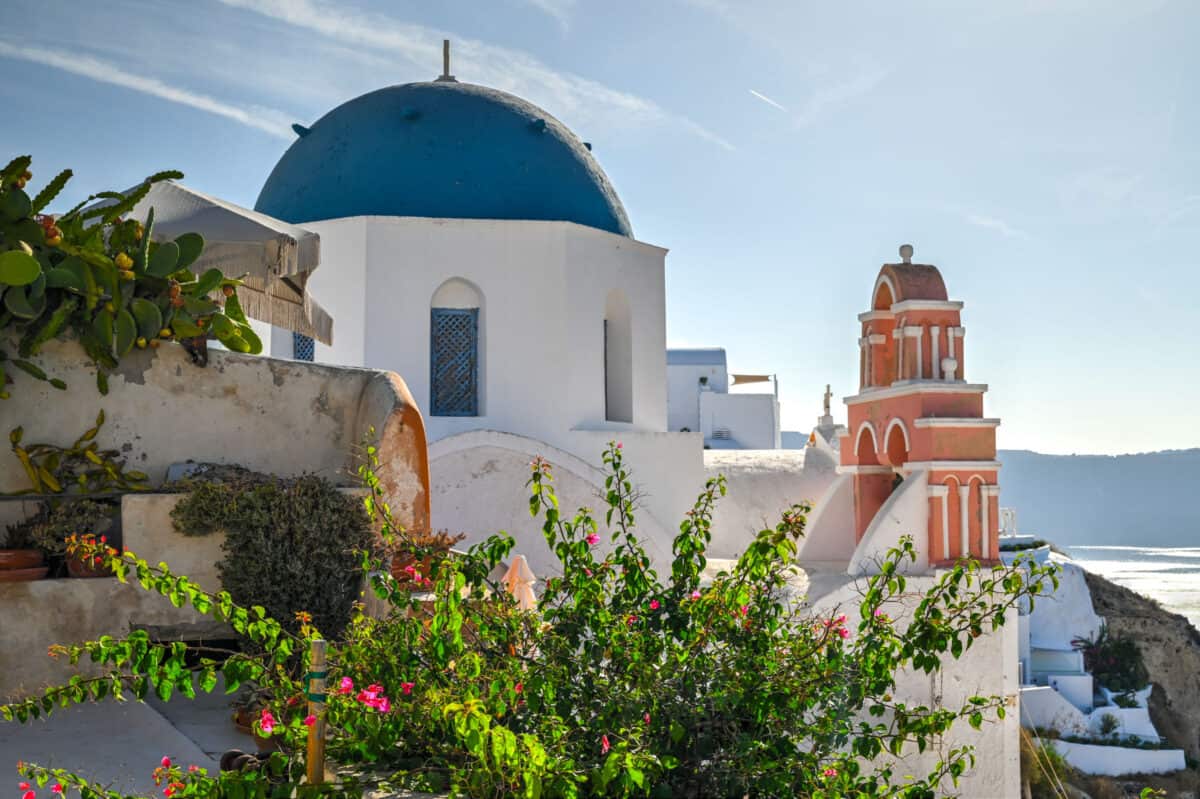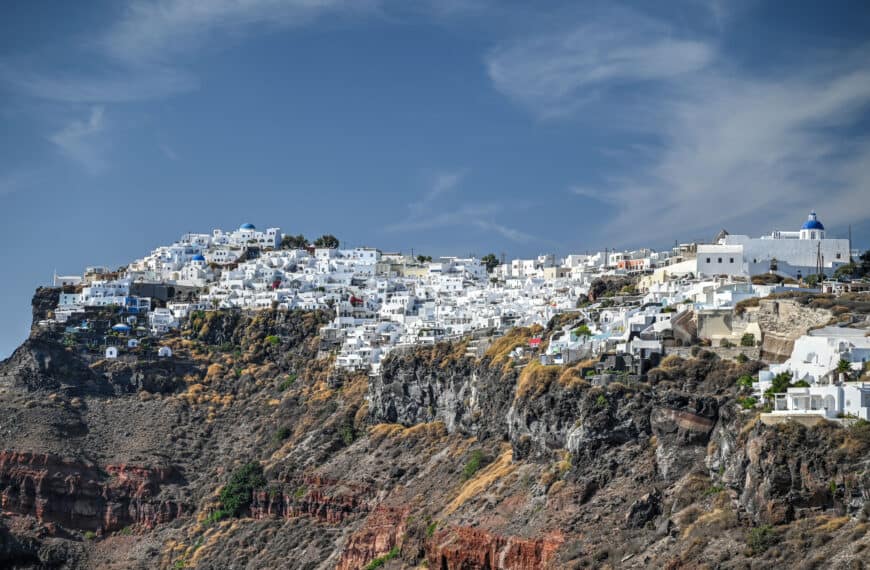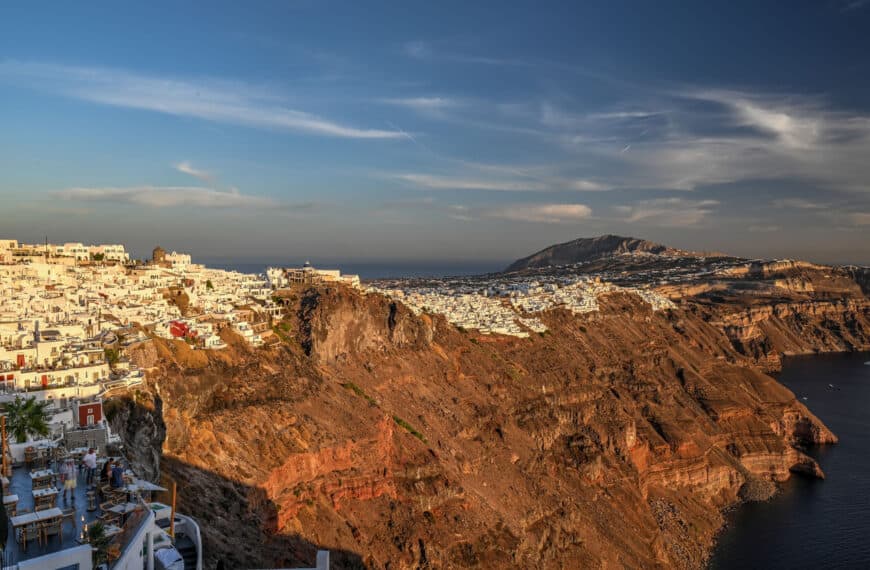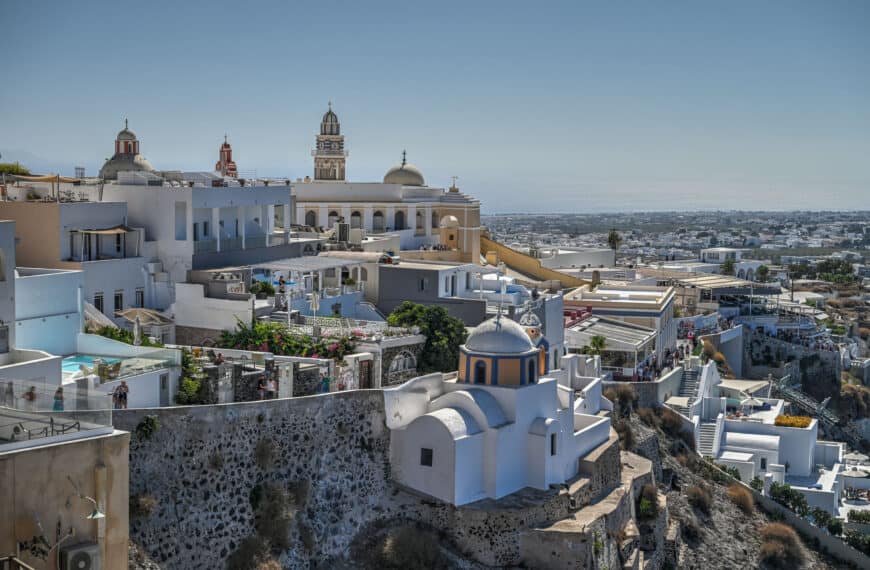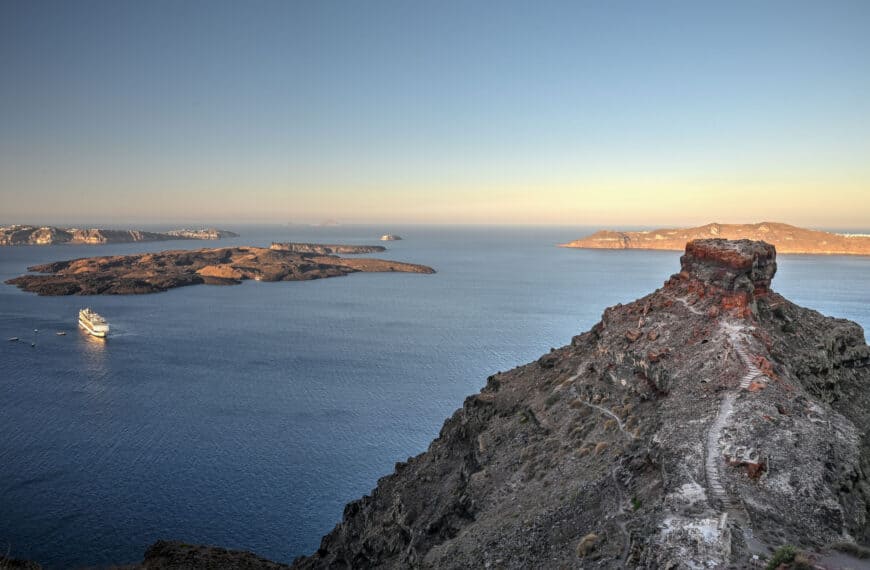Santorini is a dream and bucket-list destination for many, and rightly so. It has a rich history, breathtaking scenery, picture-perfect villages with beautiful architecture and white-washed buildings, not to mention those impressive blue-domed churches. Even if you are certain that Santorini is your next destination, you might still have some lingering questions such as what’s the best way to get to Santorini, or to travel around the island? Or when is the best time to visit? To help you with these questions and more, we put together a little Guide on some essential Santorini Travel Tips: Things to Know Before You Go, which we also hope will help you plan the perfect trip and help you get the most out of your time on this idyllic island.






Disclosure: This page (Santorini Travel Tips: Things to Know Before You Go) may contain product affiliate links. At no additional cost to you, we may receive a commission for purchases made through these links. More details can be found on our disclosure and policies page.
You might also be interested in these pages:
Best Things to See and Do in Santorini
Santorini Itinerary Ideas (1 to 5 days)
Where to Stay on Santorini
How to Get Around Santorini
About Santorini
Officially known as Thira (and Thera in classical Greek), Santorini is the largest island of a small circular archipelago, which bears the same name, and is the remnant of a volcano caldera. Only the islands of Santorini (Thira) and Thirasia are inhabited, with the most recent population estimates of Santorini around 15,500. There are no “towns” on Santorini, the whole island (and the nearby island of Thirassia) is part of one municipality, Thira. The municipality itself is divided into distinct settlements or villages, including some well-known ones such as Fira, and Oia, and some less familiar ones like Ormos and Firostefani.

Santorini is the southernmost member of the Cyclades group of islands, located approximately 200km southeast of Athens. The Cyclades are an island group in the Aegean Sea, southeast of mainland Greece, and include Mykonos, Naxos, Paros, and Santorini, among many others. Santorini is one of the only two regions of Europe featuring a desert climate. The other one is its close island neighbour of Anafi.

Santorini’s (Volcanic) History
Many people forget that Santorini is a volcano and a still active one at that. It last erupted in 1950, adding extra land mass to the central island of Nea Kameni, which is an island that is only 450 years old. Its smaller neighbour, Palia Kameni is only 2000 years old.
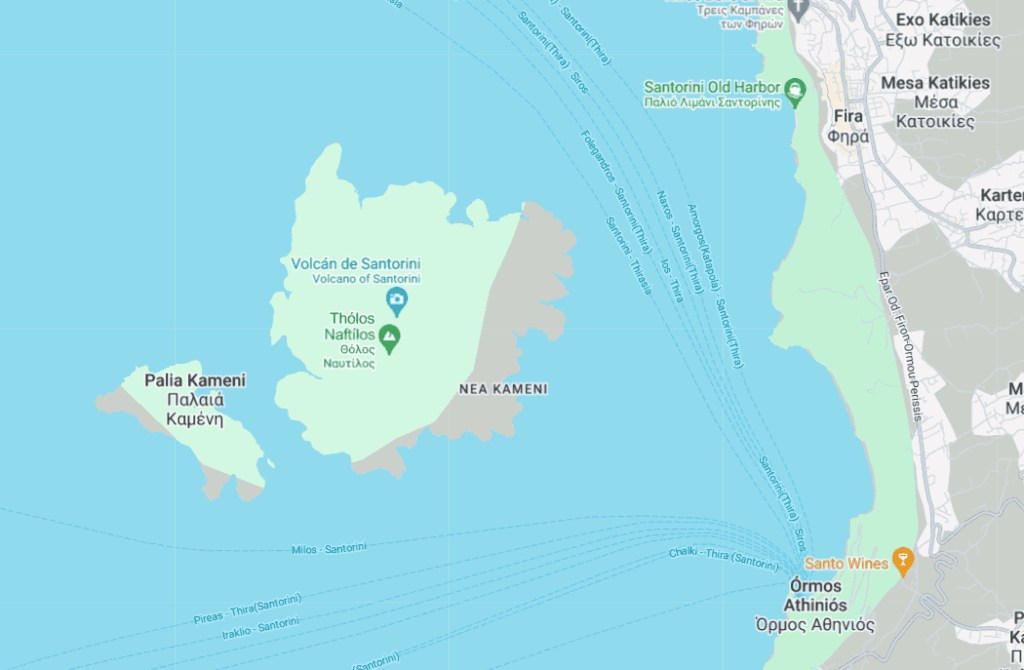
Although still an active Volcano, it does not pose any imminent threat to the population or visiting tourists. Looking at the last four eruptions dating back to the 1860s, they were all primarily of the effusive type (gentle lava flows), with intermittent weak to moderate explosive activity. These did not cause damage to Santorini or its village.
However, what did cause significant damage to several of Santorini’s villages was the devastating 1956 earthquake. The damage was severe as the earthquake demolished 529 houses and left many others damaged, particularly in Oia where nearly the entire town had to be rebuilt. It was in such a state of disrepair that it took nearly 20 years before locals started rebuilding Oia, with a vision towards tourism.




But if we go back further in time, several millennia ago, Santorini was a much larger island and was home to one of the most advanced civilizations in the ancient world, the Minoans. They built a sophisticated society centred on the city of Akrotiri.
The earliest evidence of human habitation in Akrotiri can be traced back to as early as the fifth millennium BC when it was a small fishing and farming village. It wasn’t until the Late Bronze Age, about 4000 years ago, that Akrotiri developed into one of the main urban centres and marine ports in the Aegean Sea. Akrotiri’s prosperity continued for about another 500 years; paved streets, an extensive drainage system, the production of high-quality pottery and further craft specialization all point to the level of sophistication achieved by the settlement.
This all came to an abrupt end, however, in the 16th century BC, following the massive volcanic eruption of Thira (Santorini). The eruption was one of the largest volcanic events in human history and significantly remodelled the archipelago’s geology – the form of the islands was altered and much of their surface was covered with a layer of pumice up to 60 meters thick. The eruption destroyed the Minoan settlement at Akrotiri, much like Mount Vesuvius did to Pompeii. The town was covered with ash and lava and forgotten for millennia. Thanks to recent excavations, Akrotiri is now a fantastic archeological site to visit.
Santorini Travel Tips: Things to Know Before You Go
How to Get to Santorini
You can only arrive in Santorini in one of three ways: via a flight into the airport, via a cruise ship into either the Fira Old Port or the Athinios Ferry Port, or via a Ferry into the Athinios Ferry Port.
Arrival by Plane
Santorini has a small international airport with not only daily flights from Athens during the summer but also from several major cities throughout Europe (for instance, we flew in direct from Edinburgh). We recommend using Skyscanner for the best flight deals. It’s one of two islands in the Cyclades, along with Mykonos, that has an international airport. Smaller airports that receive only domestic flights are found in Naxos, Milos, Paros and Syros.
Arrival by Ferry
As one of the Cyclade’s most popular islands, Santorini is well connected by ferry to most other major islands and Athens. If you would like to arrive in Santorini via ferry, we highly recommend using Ferry Hoppers (you can even use the search form below to start your search – it will open a new webpage with your search results). It’s great for researching ferry timetables, costs, and schedules, and booking is easy and straightforward. They also offer great customer support and have real-time ferry tracking.
We also find Ferry Hoppers very convenient to have all of our ferry crossing trips under one single app/website, even when using different ferry companies.
Important: the ferry schedules to the Greek islands are usually only announced a few months before the date of departure. So, if you can’t find routes available on Ferryhopper, please check again 1-3 months before the day you want to travel.
There are basically two types of ferries in Greece: high-speed catamarans and conventional ferries. The catamarans are faster and offer smoother rides, but are generally more expensive. Catamarans are also more susceptible to cancellations and delays in the event of rough sea weather. The conventional ferries are much larger, slower, less impacted by the weather and ideal for those travelling with a vehicle. Note that it is not unusual for the Greek Port Authorities to have to cancel all ferry operations due to poor weather and wind conditions (this typically happens a few days per year, including the summer months which are often the windiest).


Best Travel Method from Athens
This decision mostly depends on your budget, because flying is more efficient timewise. Although plane tickets might cost 2-4 times more than ferry tickets (costs fluctuate too much to give a more exact estimate), flights (50 min) will take 4-10 times less time than ferries (4-8hrs), depending on the type of ferry and the wind conditions.
The dominant winds in the Aegean Sea are from the north and are at their strongest during the summer months. This means that winds are likely to make the ferry trip to Santorini faster, but the return trip back to Athens slower. If you are keen on trying both methods, you might save time by using the ferry to Santorini and flying back to Athens, but the weather is never guaranteed.
If you plan on visiting other islands in addition to Santorini, then this should also factor into your decision. You could, for instance, fly to or from the island that is the furthest from Athens (this is likely to be Santorini), and then use the ferries between every other destination. If you plan on visiting Santorini, Mykonos and Athens, for example, then you could first fly into Santorini from Athens and then use the ferry to get to Mykonos and a second ferry to get to Athens from there.
You should know that there are two different ferry departure ports that you can use from Athens. Piraeus is the larger port and is the closest to central Athens. But if you plan on taking a ferry soon after a flight, then the Rafina Port is closest to the airport.
Best Travel Method from Mykonos
Although Mykonos also has an international airport, there are no direct flights between Mykonos and Santorini, meaning you would first have to fly to Athens to reach the other by flying. Since most ferry crossings between both islands can be done in 2-4 hours, taking a ferry between both islands is the better choice.
Leaving the Airport / Ferry Port
Don’t count on taxis – they are few and far between in Santorini (about 40 in total). We discuss your options in greater detail in our Guide on How to Get Around Santorini. Briefly, you essentially have three options.
1) Take the bus. All buses head to Fira. If that’s not your final destination, you will have to take a second bus from Fira. The Airport bus schedule is fixed, but usually, the buses departing from the Athinios Ferry Port adjust their schedule to align with when the ferries actually arrive in port (often late).
2) Rent a car. There are rental agencies in both places.
If you haven’t booked your rental vehicle yet, we highly recommend using Discover Cars to get the best rates on your rental in Santorini.
3) Pre-book a private transfer. If taking a taxi would have otherwise been your choice, then this is the best option for you. We regularly use Welcome Pickups, but there are other alternatives available on Santorini.
Arrival by Cruise Ship
If you are part of an organized group tour, then you have nothing to worry about. Most people leaving the ship to do their own thing will disembark in the Old Port of Fira.
Once in the old port, you will either have to walk up nearly 600 steps to reach Fira or take the cable car up. The cable car is obviously ideal if you have lots of luggage, only takes 4 minutes and costs €8 to go up (2024). The cable car schedule changes throughout the year: 6:30 am to 11 pm from early June till the end of August, 6:30 am to 10 pm in May, September, and October, shorter hours the rest of the year and often close for maintenance in January/February (the full schedule can be seen here). The main downside to using the cable cars is that they can get quite busy and you might have to wait a while before getting on.
You can also pay for donkey/mule rides up the staircase. Although this method has a long-standing tradition in Santorini, we don’t particularly recommend this method of transportation as there have been reports of recent animal mistreatment (see PETA investigation report).
Best Time to Visit Santorini
Our favourite time of year to visit many places in Europe, and this includes Santorini, is during the after-summer shoulder season, primarily during mid-to-late September and October. The weather is usually still great without being too hot, the days are still relatively long and the seas are still warm, and there are definitely fewer crowds than in the summer. Also, the price of accommodation and activities tends to be lower than during the high season. Alternatively, late April, May and early June are good times to visit, but you might find the seas cool for swimming.
July and August are both very busy and very hot. If these are the only months you can visit, you might want to try to maximize your early mornings and evenings for some sightseeing to stay out of the heat and the crowds.
If you plan on visiting Santorini during the off-season or winter, Fira is the best place to visit. Many of the restaurants and hotels in Santorini’s other towns will close during the off-season, but several options remain open year-round in Fira. While the weather remains relatively warm during winter (rarely dipping below 10°C with average daytime highs around 14°-15°C, rainy days are much more frequent. And it can be very windy any time of year.
How Long Should You Stay in Santorini?
To get a proper sense of everything Santorini has to offer, we think you should try to stay anywhere between 3 and 5 days. If you can only afford two days or less, that’s fine too. You’ll have time to see a few popular highlights and perhaps a few under-the-radar spots. But with more time, you will get to visit several of the smaller lesser-known villages, hike the caldera trail, relax and sunbathe on Santorini’s photogenic black-sand beaches, enjoy some wineries and vineyards, visit impressive archeological sites, and so much more.
In our Santorini Itinerary Guide, we outline different itinerary suggestions for stays of 1 up to 5 days.
Best Places to Stay in Santorini
There are so many great places and villages to choose from in Santorini. There are no wrong answers, it’s just a matter of balancing the various pros and cons of each village/area, which primarily involve costs, crowds, views, and centrality.
Fira, Imegovigli and Oia have the best caldera views. Fira and Oia are the most crowded, and Oia and Imerovigli tend to be pricier on average. Kamari and Perissa are on the opposite side of the island and are next to Santorini’s most beautiful beaches. Megalochori and Pyrgos are great options for being away from the crowds and finding cheaper accommodations, but don’t have stunning caldera views.
After weighing all the different options, we believe Imerovigli is the best place to stay in Santorini. The combination of its stunning hilltop location for sunset viewing and being a much quieter and less crowded village makes it very appealing. Also, for people who love to hike, Imerovigli is a great place to stay since several walking and hiking trails start in town: the Fira-Imerovigli walking trail, the Imergovigli-Oia hiking trail, and the hiking trail to Skaros Rock. Last but not least, given its proximity to Fira (a 30-minute walk or 5-minute bus ride), it makes a decent central base from which to explore the rest of the island.
For additional information and hotel recommendations (both in Imerovigli and elsewhere), be sure to read our Guide on Where to Stay in Santorini.
How to Get Around Santorini
You essentially have four ways to get around Sanrini: bus, rental vehicle, pre-booked private transfer, and walking. Each has its advantages and disadvantages, depending on where you are staying and where you want to go/visit. The good news is that Santorini is not a particularly large island, so it will never take you very long to get anywhere (though the traffic around Fira can slow you down in summer).
The cheapest option is definitely to take the bus, with each single route ticket costing less than 3 euros (2024). It’s particularly a convenient option for those staying in Fira (or close by), as it’s the only bus hub on the island. This means that if your initial or final destination isn’t Fira, you are likely going to need to take a first bus to Fira, and then a second to your destination.
Rental cars are more expensive, but they offer more convenience and flexibility. They are definitely the best means of transportation if you want to hit several spots in one day. You don’t necessarily need to have a car rental every day (we didn’t), but it can come in handy for a day or two depending on what you want to do. If you do decide to rent a vehicle, we highly recommend booking with Discover Cars.
Private transfers are most for getting to and from the airport/port (taxis are very rare on Santorini), but you can technically use them at any time with a pre-booking. We have had great experiences with Welcome Pickups.
We provide additional transportation travel tips in our Guide on How to Get Around Santorini.
The Cost of Visiting Santorini
Santorini is without a doubt one of the more expensive islands in Greece to visit (we felt that Myknonos was slightly more expensive), and it’s definitely more expensive than visiting most places on the mainland. That being said, we still think Santorini can definitely be visited on a budget. Using the bus system is relatively cheap to get around, and you can walk between Fira, Firostefani and Imerovigli, and you can even reach Oia via the Caldera trail.
Yes, you can splurge on restaurants and hotels offering beautiful sunset views, but you can watch the sunset for free almost anywhere along the caldera.
Santorini can be very expensive, but it certainly doesn’t have to be.
Other Santorini Travel Tips
Drinking Water
Tap water is not potable but bottled water is reasonably priced. If your hotel/accommodation doesn’t supply you with some, be sure to purchase some at the nearest market.
Toilet Paper
You can’t flush toilet paper in most places in Greece, including Santorini (Sewage system pipes are old and narrow). There will usually be a covered trash can with a liner next to the toilet where you can dispose of them.
Santorini is Very Hilly
Santorini, particularly along the caldera, is very hilly with lots of stairs everywhere – so that’s something to consider if you have mobility issues. If that is a concern, you can base yourself on the east coast where the terrain is more flat and where most of the beaches are located, such as in Perissa or Kamari.
Santorini’s many staircases can also be an issue for travelling with a suitcase.
Beaches
Speaking of beaches, most of them are composed of black sand or gravel, which gets very very hot in the summer sun. Always be sure to have shoes and sandals handy for walking along the beach. For more information on some of Santorini’s beaches, you can check out our Guide on Santorini’s Best Beaches.
Book Restaurants with Caldera Views in Advance
If you want to enjoy a beautiful meal at a restaurant with a sunset view, be sure to book ahead. Walk-ins are almost unheard of during the summer months. That being said, there are plenty of great restaurants (without the views) that don’t require reservations (we highlight a few in our Imerovigli Guide).
Preparing a trip to Santorini?
You might also be interested in these pages:
Best Things to See and Do in Santorini
Santorini Itinerary Ideas (1 to 5 days)
Santorini Travel Guide: Things to Know Before You Go
Where to Stay on Santorini
How to Get Around Santorini
Preparing a trip to Greece?
You might be interested in these Greece pages:
Top Things to See and Do in Greece
Two-Week Greece Itinerary (including Mykonos and Santorini)
Greece Travel Guide: Things to Know Before You Go
How to Travel Around Greece
We also highly recommend these guidebooks:
Rick Steeves Greece
Lonely Planet Greece
Other Travel Essentials
Travel Insurance
SafetyWing is a travel insurance company that offers comprehensive coverage for travellers. Includes Medical Insurance and Travel Insurance. Primarily geared towards long-term travellers, digital nomads, and expats.
e-Sim cards
Airalo is the world’s first and largest eSIM store with eSIM plans for 200+ countries and regions worldwide. With Airalo eSIMs, travellers can get connected the moment they land at their destination and avoid nasty data roaming charges
eSIMS are a sustainable alternative to single-use SIM cards – they are 100% digital, require less energy to produce and be re-used rather than disposed of.
Car Rentals
Discover Cars is our go-to website for car rentals. We almost always find our preferred rate there.
Transfer from Airport
Welcome Pickups is our favourite private transfer service, which you can pre-book at a fixed price. Currently available in 220 cities all over the world (mostly in Europe, but with several major cities in Asia, the Middle East and the US).
Kiwitaxi is another private transfer service – we haven’t tried it yet, but it’s currently available in a few more countries (102 as of 2024).
Hotels and Accommodations (coming soon)
Photography Gear
If you like our photography, you might be interested in some of the gear we use to shoot our travel and hiking destinations.
Camera Body – Nikon Z 6ii Fx-series Mirrorless Body
Main Lens – NIKON 24-120mm F/4G ED VR AF-S
Zoom Lens – Sigma 745-306 150-600mm f/5-6.3
Polarizing filters – Urth Circular Polarizing (CPL)
Camera Tripod – K&F Concept 64-inch Camera Tripod
Mini-tripod – Lammcou Flexible Camera Tripod
Camera/hiking backpack – Vanguard Alta Rise 48 Backpack
Universal Travel Adapter – VYLEE Universal International Power Travel Plug
Photography Prints
If you found this blog useful, you can help support our blog by purchasing low-cost digital prints. Printed physical prints are also available for purchase.








—–
Well, that wraps it up! We hope you enjoyed our Santorini Travel Tips: Things to Know Before You Go guide and that it will prove useful for planning your trip to Santorini.
—–
You might also be interested in these related pages:
